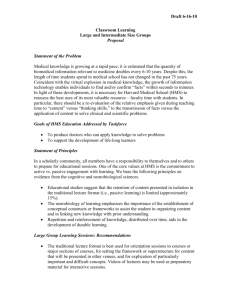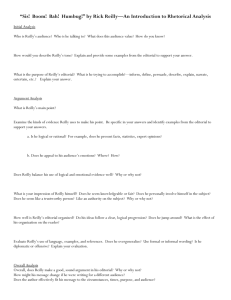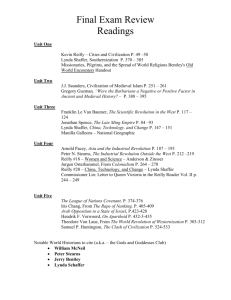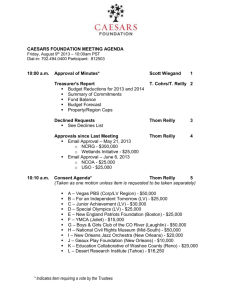Opening the Floodgates of Usability
advertisement
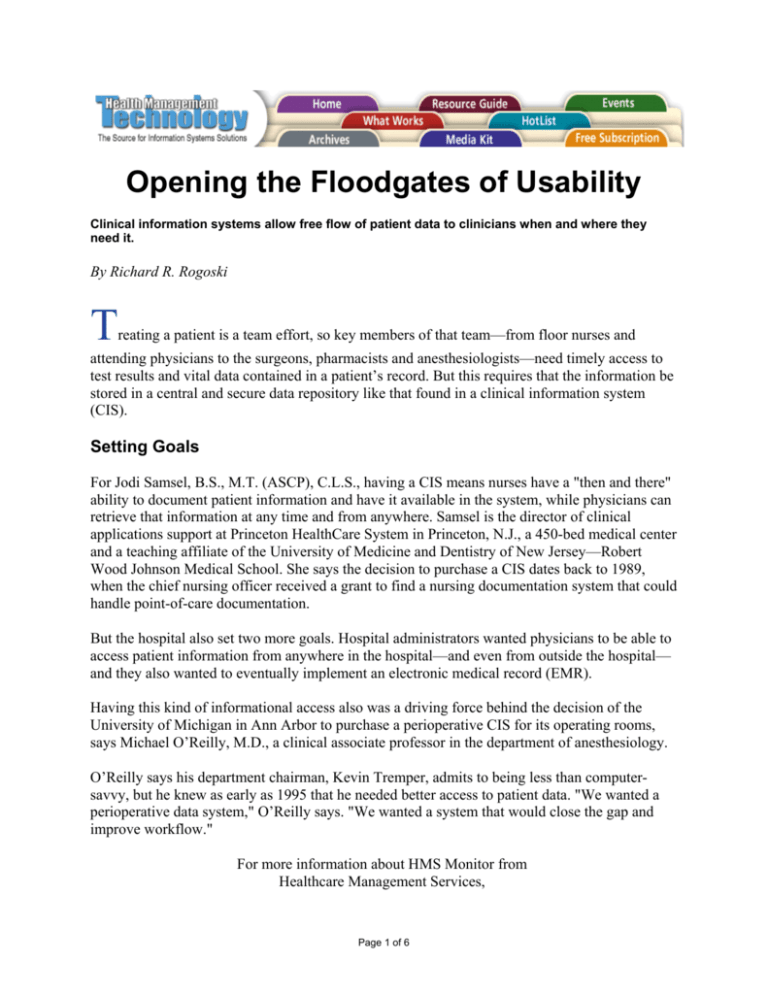
Opening the Floodgates of Usability Clinical information systems allow free flow of patient data to clinicians when and where they need it. By Richard R. Rogoski T reating a patient is a team effort, so key members of that team—from floor nurses and attending physicians to the surgeons, pharmacists and anesthesiologists—need timely access to test results and vital data contained in a patient’s record. But this requires that the information be stored in a central and secure data repository like that found in a clinical information system (CIS). Setting Goals For Jodi Samsel, B.S., M.T. (ASCP), C.L.S., having a CIS means nurses have a "then and there" ability to document patient information and have it available in the system, while physicians can retrieve that information at any time and from anywhere. Samsel is the director of clinical applications support at Princeton HealthCare System in Princeton, N.J., a 450-bed medical center and a teaching affiliate of the University of Medicine and Dentistry of New Jersey—Robert Wood Johnson Medical School. She says the decision to purchase a CIS dates back to 1989, when the chief nursing officer received a grant to find a nursing documentation system that could handle point-of-care documentation. But the hospital also set two more goals. Hospital administrators wanted physicians to be able to access patient information from anywhere in the hospital—and even from outside the hospital— and they also wanted to eventually implement an electronic medical record (EMR). Having this kind of informational access also was a driving force behind the decision of the University of Michigan in Ann Arbor to purchase a perioperative CIS for its operating rooms, says Michael O’Reilly, M.D., a clinical associate professor in the department of anesthesiology. O’Reilly says his department chairman, Kevin Tremper, admits to being less than computersavvy, but he knew as early as 1995 that he needed better access to patient data. "We wanted a perioperative data system," O’Reilly says. "We wanted a system that would close the gap and improve workflow." For more information about HMS Monitor from Healthcare Management Services, Page 1 of 6 www.rsleads.com/309ht-203 For more information about the perioperative capability of GE Medical’s Centricity CIS, www.rsleads.com/309ht-204 For more information about Misys CPR and Misys CPOE (formerly Patient1 from Per-Se), www.rsleads.com/309ht-205 As O’Reilly explains, many surgical patients were being seen for pre-surgical tests such as a stress test, but the results were recorded on paper charts that were often filed away in file cabinets. "There was no way for the anesthesiologist to know what tests were administered or what the results were. It was critical to have this information before surgery, because our role is to make sure all organ systems remain healthy during surgery. Usually, it was easier just to call the patient and ask him a lot of questions all over again," he says. Likewise, determining if the patient was allergic to medications often resulted in duplication of efforts. O’Reilly says, "If five different people ask a patient, ‘What drugs are you allergic to?’ the patient says, ‘Don’t you guys talk to each other?’" Not having all this information when it’s needed can delay moving a patient into the OR or result in the surgery being rescheduled. "ORs are expensive," says O’Reilly. "We don’t want them empty." Consent forms posed another problem. He says that patients would move through the system faster than paper, and often they would get to the OR before the paper did. With hundreds of surgeons performing 35,000 surgeries annually, collection and dissemination of data had to be done electronically. Doing away with paper and giving the healthcare team greater access to patient data also prompted Fairfield Memorial Hospital in Fairfield, Ill., to invest in a series of electronic patient care modules. Cindy Meagher, R.N., the hospital’s assistant director of nursing, says a primary goal was "to get everything onto one plate" so various data could be entered into a patient’s record and accessed from any computer. "There was no link," she says. "Everybody was doing his own thing." But not anymore. "The CIS has helped make everyone into a multidisciplinary team as opposed to silos or separate departments. It has allowed us to function as a single unit. From the documentation perspective, automation helps, because now when a nurse inputs information into a patient’s initial assessment, she can view the patient’s record at the same time. If the patient has a patient hospitalization history with us, all that information is available to the nurse at assessment time," says Meagher. Page 2 of 6 Getting Started With the search for a CIS beginning in earnest in 1989, Princeton HealthCare System signed a contract in 1991 with Health Data Sciences (HDS) for a product then known as UltiCare. Subsequently, HDS was acquired by Atlanta-based Per-Se Technologies Inc., and the product was renamed Patient1. [Editor’s note: Per-Se Technologies announced in June that it sold Patient1 to Raleigh, N.C.-based Misys Healthcare Systems, which is planning to enhance and market the product under the names Misys CPR and Misys CPOE.] For Samsel, installing the new system entailed an extensive overhaul of the hospital’s information systems. "In March 1992, we converted nursing documentation, pharmacy, radiology, cardiopulmonology, nutrition—everything but the lab—to what became Patient1 from Per-Se," she says. The lab has been using Cerner’s Classic laboratory information system since 1989 and, because it is moving to HL7, will soon convert to Cerner’s Millennium product. Even so, Samsel says a custom interface was designed linking the lab’s system to Patient1. Transitioning to a CIS was more complicated for the University of Michigan’s anesthesiology department, admits O’Reilly, who says the organization went through three systems before finding a keeper. The first vendor lasted only a couple of months. Without a product remotely resembling what the hospital said it wanted, "they used a form generator to create forms like ours," O’Reilly says. The second vendor had better luck, lasting about a year-and-a-half. "Their technology was a little antiquated and had some architecture problems. We wanted a system that would automatically page the anesthesiologist when the patient arrived," he says. The third vendor, SEC Inc.—which was founded by two physicians and was later acquired by Milwaukee, Wis.-based GE Medical Systems Information Technologies—was strong on patient history and physical data but lacked a physiological component. Yet, SEC agreed to work with the anesthesiology department to develop the kind of system the hospital wanted. "Before the third vendor, this project was going down the tubes," O’Reilly admits. After being acquired by GE, the product was named the Centricity Perioperative Clinical Information System and is the one the University now uses. A First Time for Everything Fairfield Memorial Hospital had an easier time finding a vendor, largely because the decision to install an electronic patient care system followed on the heels of the decision to automate. Page 3 of 6 "When the facility was completely renovated four years ago, we put computers at all the nursing stations," explains Meagher. "Nursing had not had any computers until then. The entire hospital was paper-based. Everything was done with paper, phone calls and faxes." Designated under federal guidelines as a "critical access hospital," Fairfield Memorial has 29 acute care beds, 30 skilled-nursing beds and 100 long-term care beds. While it has an ER, an OR and an OB/GYN department, it doesn’t have an IT department. According to Meagher, IT decisions are made as a team effort that includes Meagher on the clinical side, Maryann Harrison as the business office manager and Mike Brown, the chief financial officer. Choosing Nashville, Tenn.-based Healthcare Management Systems Inc. (HMS), the hospital began installing most of the modules in the HMS Monitor product line. "We have the entire patient care module, pharmacy, radiology, laboratory, order entry and results, dictation and transcription, and the business office module," Meagher notes. "It took us about a year to implement most of the modules, starting in the business office, moving toward order entry and results, and then patient care." Currently, the hospital is in the process of implementing an electronic medication administration record (MAR) module that HMS is custom designing, Meagher says. But she admits there have been a few challenges. "It’s typical for a hospital of our size not to have a 24-hour pharmacist," she explains. "We needed the order-entry piece of the electronic MAR so nurses could use that portion of it." However, having relied on a paper medication administration record for so long, nurses were unfamiliar with HMS’s standard order-entry component. "It took a lot of steps to get an order in," says Meagher. "There were a lot of windows, and it took searching for medications," so HMS streamlined the order-entry component and added a new search engine. Meanwhile, the hospital cleaned up its formulary so it contained only those medications actually being used. But that didn’t totally solve the problem. Since the new electronic MAR is Java-based, the hospital’s IBM AS400 mainframe—which was adequate for all the other modules—didn’t have enough memory or processing power. The hospital has begun a major hardware upgrade, says Meagher. Reaping the Rewards Even though implementing an electronic MAR remains a work in progress, Meagher says her hospital has already benefited from installing the HMS Monitor modules. "Having the HMS system has literally put information at our fingertips, whereas before, we were file-based and paper-based." Page 4 of 6 She says that when the hospital purchased the HMS system, it also invested in IBM wireless laptops that are mounted on mobile carts and allow nurses to perform assessments and documentation at the patient’s bedside. Finally, the hospital has begun moving away from paper records. "We still do hold a paper record after discharge, and we are rapidly running out of room for storing medical records," Meagher says. The HMS system allows for the creation of a condensed version, and by the hospital’s conversion to an EMR that can still be stored in the medical records department after discharge, the paper records can be shredded. But a lot of work remains. Fairfield Memorial has yet to purchase the HMS Monitor component specifically designed for physicians, Meagher notes. Docs Onboard Physicians at Princeton HealthCare System already use Patient1, and the chart review function gets the most extensive use, according to Samsel. In fact, she says most physicians were quick to come onboard. "In 1996, we initiated a project to bring up the residents on direct order entry or CPOE," she says. "There was substantial data collection with residents, and we spent a lot of time teaching them. Then they taught each other." Even some of the attending physicians expressed an interest. Right now, about 42 percent of attendings use the order-entry system, while 98 percent of residents enter orders electronically. To make it more attractive to physicians, the hospital will roll out in March 2004 an intuitive, Web-based, GUI-based order-entry functionality that Samsel hopes will achieve even stronger physician buy-in. Also scheduled for 2004 is a rollout of an electronic, bar coded MAR, she notes. By that time, Patient1 (as the newly renamed Misys CPR/CPOE) should have that capability in place, and the hospital will have upgraded its hardware to include the necessary bar coding equipment. Still, Samsel says the current IT has greatly improved workflow and access to information throughout the hospital. Each patient room has a hard-wired, diskless workstation, and plans are now in the works to make the system available on mobile carts so documentation can be done at the bedside. Because chart review is archived into the system, physicians can access a patient’s record from anywhere in the hospital, from their offices or even from their homes, Samsel adds. Also, 110 visiting nurses now have laptops with wireless CDPD (cellular digital packet data) capability, so these nurses can access and send information directly from a patient’s home without having to plug into a phone jack. One of the hospital’s goals was to fully implement an EMR, and Samsel says it already has 85 percent of that EMR in place. Lessons Learned Page 5 of 6 Now that the University of Michigan has the kind of perioperative CIS it wanted from the start, O’Reilly applauds the benefits the system has generated. "The major problem to be solved was that multiple people needed the same information at the same time to make the right patient care decisions. But they were all in different places, so paper was completely unsuitable. The data is now available to everyone in the healthcare organization via a Web browser, so getting information simultaneously is no longer a problem." Although O’Reilly questions whether a centralized IT department is always in tune with the specific needs of clinical departments, he says the University of Michigan’s IT department actually led the efforts to upgrade the healthcare infrastructure, including the installation of new servers that the Centricity system required. It wasn’t long before the system was up and running. "We went live in June 1999 with the patient advanced testing clinic, then QA documentation," he says. "Now we’re working on implementing the system in all operating rooms. We want OR information to be available to the entire healthcare enterprise at the University of Michigan, and this system will do it." O’Reilly says he learned a number of lessons during the search for an operable system. One of the most important, he says is, "What you want may not be what you need. We wanted an anesthesiology information system, but what we really needed was a clinical information system." Another bit of advice he offers is to pay close attention to what vendors promise. "There’s a big difference between a vendor saying, ‘We can do this,’ and a vendor saying, ‘We do do this.’ You have to ask them, ‘Do you do this now?’" By working closely with the vendor, O’Reilly and Tremper were able to get the features they wanted and needed including real-time data through interfaces to ADT, lab, pharmacy, radiology and dictation, including EKG results; the viewing of multiple organ systems on a single screen; automatic paging or e-mail to alert staff of incomplete documentation prior to surgery; and automatic paging to alert staff when the patient is ready. Interestingly, even though installing this system led to a radical change in the way data was collected and managed, there was little resistance from anyone on staff. "You’ve got to have leadership," O’Reilly explains. "It’s all about changing the way you do your job, and some people don’t want to change. That’s where strong leadership is critical." Richard R. Rogoski is a free-lance writer and a contributing editor to HMT. Contact him at rogoski@ aol.com. © 2003 Nelson Publishing, Inc Page 6 of 6
